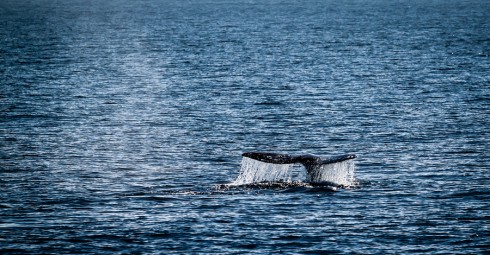| March 16th, 2016 | | | SofiaBlog |
Now’s one of the very best times of year to watch whales along the San Diego coast. That’s because the northbound leg of the mammalian migration on Earth is underway right now in our watery front yard!
Thousands and thousands of gray whales are cruising up our coast between their Baja Californian nursery waters and Alaskan feeding grounds, a 10,000-mile round-trip odyssey. (A smaller proportion are, increasingly, summering off the West Coast.) Among them are females with calves recently born down in Mexico. Roughly February through May is the peak time to look, which means we’re right in the thick of prime whale-watching opportunities.
And those mother-calf pairs especially tend to really hug the coastline—partly, scientists suspect, to try to steer clear of orcas, which try to intercept the vulnerable calves this time of year. With the whales right offshore—and moving a bit slower, given the calves’ need to rest—land-based whale-watching really doesn’t get any better than this time of year.
Ideal spots are headlands here the coastline juts out: The seaside heights provide great prospects, for one thing, and the whales tend to tightly round the protruding points. Good bets in the area include Torrey Pines State Reserve, Ellen Browning Scripps Park and the Scripps Aquarium at La Jolla, and Cabrillo National Monument, especially the Old Point Loma Lighthouse and the aptly named Whale Overlook.
The best way to spot a whale is to scan a broad swath of ocean and look for the characteristic wispy blows of an exhaling animal, which—to a practiced eye—stand out even in choppy whitecaps. Gray whales on the move tend to make sequences of three to five spouts (up to 15 feet high) every 30 seconds or so. With a good perspective and good light, you’ll often see, on the heels of a blow, the whale’s gray, blotchy back, the ridged or “knuckled” tail, and the big flukes. A feeding whale making a deep dive may hoist those flukes straight up out of the water as it plunges. Lucky observers might spot a gray breaching or spy-hopping (sticking its head straight up out of the water).
Remember, patience really pays off. Stake out for awhile at one of those commanding vantages, and you’ve got a good chance of seeing whales. Even when you’re not, you can be soaking up the gorgeous scenery of the San Diego coastline—and who knows what else you might spot, from pelicans to sea lions.
If enjoying the migration from shore has you hooked, remember that numerous San Diego tour operators also offer whale-watching cruises for up-close glimpses of the gentle leviathans.
Don’t miss out on this spring’s whale-watching action. Come stay with us at the Sofia Hotel, and enjoy firsthand one of the most impressive journeys in the animal kingdom!












